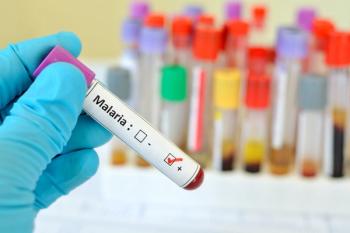Pharmacy Practice in Focus: Oncology
- August 2025
- Volume 7
- Issue 6
From ECHELON-3 to Clinical Practice: Newly Approved Brentuximab Vedotin With Lenalidomide and Rituximab for R/R DLBCL
Key Takeaways
- The BV-R2 combination offers a new treatment option for R/R DLBCL patients ineligible for SCT or CAR T-cell therapy, improving survival and response rates.
- ECHELON-3 trial results show significant efficacy, with improved overall survival and progression-free survival compared to control, even in high-risk subgroups.
BV-R2 combination shows survival benefit across high-risk subgroups.
The recent approval of brentuximab vedotin (BV, Adcetris; Seagen Inc) in combination with lenalidomide (Len, Revlimid; Bristol Myers Squibb) and a rituximab (R; BV-R2) product is a pivotal moment in cancer therapeutics and provides an alternative treatment for adult patients with relapsed or refractory diffuse large B-cell lymphoma (R/R DLBCL). This approval is especially significant for patients deemed ineligible for stem cell transplant (SCT) or chimeric antigen receptor (CAR) T-cell therapy, who previously had limited treatment options.1 Consequently, this approval of BV with Len and an R product (BV-R2) prompts a reevaluation of the treatment landscape for R/R DLBCL.
Prior to this approval, adult patients diagnosed with R/R DLBCL who are ineligible for other treatments were a population with an unmet medical need. Therefore, the BV combination therapy’s mechanism of action, clinical trial results, and adverse effect (AE) profile all provide a way for more patients to receive treatment. The approval continues to show the growth of therapeutic options for those with R/R DLBCL, as well as how BV-R2 offers improved survival and quality of life to a larger range of patients.
Another area that affects the treatment landscape of this newly approved medication lies in accessibility to patients. Cost, insurance, and health care resources will dictate who can use the treatment. The recommended dose is 1.2 mg/kg up to a maximum of 120 mg in combination with Len and R administered every 3 weeks until disease progression or unacceptable toxicity.1 Therefore, having enough resources and an established protocol to support assessment is required for optimal medication use.
Targeted and Synergistic: Why This Triplet Regimen Works
The newly approved combination of BV-R2 for patients with R/R DLBCL offers a meaningful therapeutic advance, particularly for those who are ineligible for autologous SCT (ASCT) or CAR T-cell therapy. This recommendation is grounded in the results of the phase 3 ECHELON-3 trial (NCT04404283), a double-blind, randomized, multicenter study comparing BV-R2 with placebo plus Len plus R in a population reflective of current clinical practice. The median patient age was 74 years, underscoring the applicability of the regimen to an older population often excluded from aggressive therapies.2
ECHELON-3 enrolled 230 patients with R/R DLBCL who had received at least 2 prior lines of systemic therapy, with many exhibiting high-risk features. Among the population, 29% had received prior CAR T-cell therapy, 15% had received bispecific antibodies, and 12% had previously undergone ASCT. The median number of prior therapies was 3, and 70% of patients were CD30-negative—defined as having less than 1% of cells expressing CD30—a key consideration given that BV targets CD30. Yet the combination provided clinical benefit regardless of CD30 expression or cell of origin, reflecting a broader mechanism of action.2,3
Efficacy outcomes in ECHELON-3 were clinically significant with the potential to shift treatment standards. The median overall survival (OS) for patients receiving BV-R2 was 13.8 months, compared with 8.5 months in the control arm, corresponding to a 37% reduction in the risk of death (HR, 0.63; P = .009). Progression-free survival (PFS) was also improved: 4.2 months vs 2.6 months, a 47% reduction in the risk of disease progression or death (HR, 0.53; P < .001). The overall response rate (ORR) in the BV-R2 arm was 64%, with a complete response (CR) rate of 40%, compared with 42% and 19%, respectively, in the control arm. Importantly, the BV-R2 regimen demonstrated a median duration of response of 8.3 months and a median duration of CR of 18.9 months among patients who achieved a CR. These findings underscore the durability of responses achieved with this investigational regimen. The ORR was 64%, with a CR rate of 40%, reinforcing the substantial clinical benefit observed with BV-R2 in the R/R setting.2
Subgroup analyses confirmed the consistency of benefit across multiple high-risk categories. In patients 65 years or older, PFS was 5.7 months with BV-R2 compared with 2.8 months in the control group (HR, 0.48), an important clinical finding as older adults with R/R disease often have limited treatment options and may be less tolerant of intensive therapies. Notably, patients who had previously received CAR T-cell therapy also demonstrated improved outcomes with BV-R2, showing a median OS of 13.6 months vs 6.5 months in controls (HR, 0.54). Additionally, even among patients with low CD30 expression (< 1%), median OS reached 15.6 months in the BV-R2 arm compared with 6.5 months in the control arm, reinforcing the efficacy of this regimen across biologically diverse and heavily pretreated populations.2
In terms of safety, the triplet regimen was generally well tolerated. The most common grade 3 or higher AE included neutropenia (43%), thrombocytopenia (25%), and anemia (22%). Notably, treatment discontinuation rates due to AEs were 15% in the BV-R2 group, which is acceptable given the advanced disease setting and lack of curative alternatives.2
When compared with historical benchmarks such as SCHOLAR-1 data, which showed a median OS of 6.3 months in refractory DLBCL, ECHELON-3 data represent a substantial improvement.4-6 Although CAR T-cell therapies and bispecific antibodies have emerged as second- and third-line treatments, these treatments have significant logistical and toxicity burdens, including cytokine release syndrome and neurotoxicity, making them unsuitable for all patients. In contrast, BV-R2 is administered in the outpatient setting, does not require hospitalization, and has a favorable benefit-risk ratio, making it accessible and scalable across a broader population.2
Mechanistically, the synergy among BV, Len, and R underpins the combination’s efficacy. BV, an antibody drug conjugate (ADC) targeting CD30, mediates cytotoxicity and contributes to regulatory T-cell depletion and tumor microenvironment modulation.2 Len enhances immune response and promotes antibody-dependent cellular cytotoxicity, whereas R targets CD20-expressing B cells.4,5 This multimodal immune engagement likely contributes to the response observed even in patients with low CD30 expression.
In conclusion, the combination of BV, Len, and R offers a clinically meaningful, safe, and well-tolerated treatment option for patients with heavily pretreated R/R DLBCL. Its efficacy across high-risk subgroups, including older patients and those previously treated with CAR T or bispecifics, positions it as a compelling option in the third-line or later setting. As supported by the ECHELON-3 data, this combination fills a critical gap in the treatment landscape and is well aligned with current goals to provide outpatient, targeted, and chemotherapy-free options for challenging hematologic malignancies.
AE Profile
In October 2023, the FDA approved a triplet-therapy regimen combining BV, Len, and R for use in the treatment of patients with otherwise unclassifiable R/R DLBCL who are not candidates for ASCT. The approval was based on results from the phase 2 ECHELON-3 trial, which showed favorable efficacy but highlighted considerable AEs of the triplet therapy.
BV is an ADC that targets CD30 specifically and is attached to the microtubule-disrupting agent monomethyl auristatin E. Reported AEs include peripheral neuropathy, fatigue, nausea, neutropenia, and infections. The development of grade 2 or higher peripheral neuropathy has been shown to increase with cumulative treatment, thus necessitating close monitoring and possibly altering the dosage.2
Len, an immunomodulatory drug, contributes to the myelosuppression that characterizes the treatment regimen. Common AEs include neutropenia, thrombocytopenia, asthenia, cutaneous reactions, and gastrointestinal upset. The agent also has a black box warning for its teratogenicity potential and increased risk for venous thromboembolism (VTE), especially when used with other pharmacologic therapy.4
R, an anti-CD20 monoclonal antibody, is known for infusion-related reactions, cytopenias, and infection risk. This includes hepatitis B reactivation and progressive multifocal leukoencephalopathy.5
Within the context of ECHELON-3 data, the most frequent grade 3 or greater treatment-emergent AEs in the BV-Len-R group compared with the placebo-Len-R group were neutropenia (43% vs 28%), thrombocytopenia (25% vs 19%), and anemia (22% vs 21%). Febrile neutropenia occurred in 9% of patients receiving the triplet therapy. With consideration for the overlapping toxicities involving myelosuppression and increased risk for infection, complete blood counts and liver studies should be undertaken, and neurological symptoms regularly checked. In addition, thromboprophylaxis should be instituted for those who are taking Len to prevent the risk of VTE.1
Overall, although the combination therapy offers a novel option for heavily pretreated patients with DLBCL, clinicians must be vigilant in managing the therapy’s cumulative toxicity profile.
Pharmacist Involvement
The approval of the novel combination of BV, Len, and R also provides ways for pharmacists to be involved in the successful integration into clinical practice. Key responsibilities include the following:
• Patient selection: Accurate identification of patients who are eligible for the approved combination can support oncologists. Pharmacists can aid in selecting patients who have received at least 2 lines of treatment and are ineligible for ASCT and CAR T-cell therapy.
• AE management: Pharmacists are critical in monitoring therapy responses and identifying and managing AEs, such as neutropenia, peripheral neuropathy, and infections. Their expertise ensures the safe administration of drugs, minimizes potential risks, maintains patient adherence, and optimizes overall quality of life. Additionally, pharmacists can provide educational materials to patients and providers on AE recognition.
• Therapeutic and safety monitoring: Pharmacists can assess treatment response, adjust dosing schedules, and monitor for disease progression. These assessments can then be properly communicated to oncologists and patients.
• Patient education and empowerment: Pharmacists have the unique opportunity of providing education to patients regarding benefits and AEs and answering questions the patient may have regarding this medication. Additionally, pharmacists can empower patients to be involved in their treatment plan.
Conclusion
The FDA approval of the BV-R2 combination represents a major advance in the treatment of patients with R/R DLBCL, especially those who are ineligible for ASCT or CAR T-cell therapy. Backed by robust ECHELON-3 data, this triplet regimen offers improved survival outcomes, durable responses, and manageable toxicity, even among high-risk and heavily pretreated patient populations. Its outpatient administration and chemotherapy-free approach further enhance its practicality and scalability across clinical settings.
However, the regimen’s overlapping AEs, particularly myelosuppression and peripheral neuropathy, necessitate close monitoring and proactive supportive care. Pharmacists are uniquely positioned to optimize patient selection, manage toxicities, monitor therapy, and provide education, ensuring patients use this regimen safely and effectively. As the treatment paradigm for R/R DLBCL evolves, BV-R2 offers a meaningful and accessible option that fills a long-standing gap in care.
REFERENCES
FDA approves brentuximab vedotin with lenalidomide and rituximab for relapsed or refractory large B-cell lymphoma. FDA. Updated February 12, 2025. Accessed May 15, 2025. https://www.fda.gov/drugs/resources-information-approveddrugs/fda-approves-brentuximab-vedotin-lenalidomide-andrituximab-relapsed-or-refractory-large-b-cell
Bartlett NL, Hahn U, Kim WS, et al. Brentuximab vedotin combination for relapsed diffuse large B-cell lymphoma. J Clin Oncol. 2025;43(9):1061-1072. doi:10.1200/JCO-24-02242
US FDA approves Pfizer’s ADCETRIS combination regimen for the treatment of relapsed/refractory diffuse large B-cell lymphoma. News release. Pfizer Inc. February 12, 2025. Accessed May 17, 2025. https://www.pfizer.com/news/press-release/press-release-detail/us-fda-approvespfizers-adcetrisr-combination-regimen
Revlimid. Prescribing information. Bristol Myers Squibb; 2023. Accessed May 17, 2025. https://www.accessdata.fda.gov/drugsatfda_docs/label/2019/021880s057lbl.pdf
Rituxan. Prescribing information. Genentech, Inc; 2023. Accessed May 17, 2025. https://www.gene.com/download/pdf/rituxan_prescribing.pdf
Crump M, Neelapu SS, Farooq U, et al. Outcomes in refractory diffuse large B-cell lymphoma: results from the international SCHOLAR-1 study. Blood. 2017;130(16):1800-1808. doi:10.1182/blood-2017-03-769620
Articles in this issue
Newsletter
Stay informed on drug updates, treatment guidelines, and pharmacy practice trends—subscribe to Pharmacy Times for weekly clinical insights.





